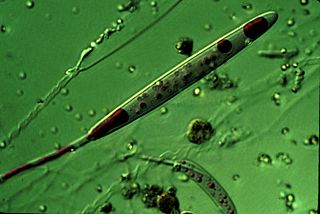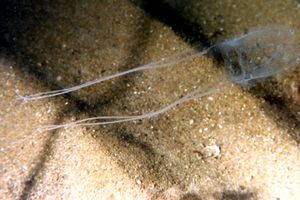
A cnidocyte is an explosive cell containing one large secretory organelle called a cnidocyst that can deliver a sting to other organisms. The presence of this cell defines the phylum Cnidaria. Cnidae are used to capture prey and as a defense against predators. A cnidocyte fires a structure that contains a toxin within the cnidocyst; this is responsible for the stings delivered by a cnidarian.

Box jellyfish are cnidarian invertebrates distinguished by their box-like body. Some species of box jellyfish produce potent venom delivered by contact with their tentacles. Stings from some species, including Chironex fleckeri, Carukia barnesi, Malo kingi, and a few others, are extremely painful and often fatal to humans.

Irukandji syndrome is a condition that results from envenomation by certain box jellyfish. In rare instances the sting may result in cardiac arrest and death. The most common jellyfish involved is the Carukia barnesi, a species of Irukandji jellyfish. Those stung may experience severe or even excruciating pain.

Chironex fleckeri, commonly known as the Australian box jelly, and nicknamed the sea wasp, is a species of extremely venomous box jellyfish found in coastal waters from northern Australia and New Guinea to Indonesia, Cambodia, Malaysia and Singapore, the Philippines and Vietnam. It has been described as "the most lethal jellyfish in the world", with at least 64 known deaths in Australia from 1884 to 2021.

The Irukandji jellyfish are any of several similar, extremely venomous species of rare jellyfish. With a very small adult size of about a cubic centimetre (1 cm3), they are both the smallest and one of the most venomous jellyfish in the world. They inhabit the northern marine waters of Australia, and cost the Australian government $AUD 3 billion annually through medical costs associated with stings and tourism losses. This type of jellyfish reproduces sexually with eggs and sperm. They fire their stingers into their victim, causing a condition known in humans as Irukandji syndrome, which can be fatal and difficult to immediately recognize due to the delayed effects of the venom. There are about 16 known species of Irukandji, of which Carukia barnesi, Malo kingi, Malo maxima, Malo filipina and Malo bella are the best known.

Carybdea is a genus of venomous box jellyfish within the family Carybdeidae that currently consists of a total of 8 species. This genus of jellyfish are often found in warm waters around the world in waters such as the Mediterranean Sea, the Pacific Ocean, and off the coast of Africa. Their sting can cause a range of effects depending on the species. These invertebrates will go through both sexual and asexual reproduction as they transform from a polyp to medusa. Carybdea have a box-shaped bell with four tentacles and eye-like sensory structures. There are distinct physical markings that differentiate many species within the genus. While Carybdea use their venom to act as predators, they are also preyed on by turtles and various fish. They feed on plankton, invertebrates, fish, and some crustaceans.

Chirodropidae is a family of venomous box jellyfish within the class Cubozoa. Like other members of the order Chirodropida, they have branched pedalia, in contrast to the unbranched pedalia of box jellyfish in the order Carybdeida. Each branch houses its own individual tentacle. Nematocyst composition and type can vary among individuals within this family based on body size and life stage. Like other box jellyfish, chirodropids can be found in coastal and shallow marine areas, but they have also been found to occur at benthic depths.

Malo is one a genus of box jellies in the family Carybdeida in the Phylum Cnidaria. It has four known species, three of which were described by the Australian marine biologist Lisa-Ann Gershwin. The genus was discovered in 2005. Many of the species are known for their paralytic and deadly affect. Many species in the Malo genus are very small and hard to capture and study. Many species of Malo have been captured on the Western and Eastern cost of Australia. Malo appear to be solidarity jellies.

Malo kingi or the common kingslayer is a species of Irukandji jellyfish. It was first described to science in 2007, and is one of four species in the genus Malo. It has one of the world's most potent venoms, even though it is no bigger than a human thumbnail. As an Irukandji, it can cause Irukandji syndrome, characterized by severe pain, vomiting, and rapid rise in blood pressure.

Carukia barnesi is an extremely venomous jellyfish found near Australia. Stings can result in Irukandji syndrome, and this species is commonly known as Irukandji jellyfish, although this name does not distinguish it from other Irukandji jellyfish such as Malo kingi.

Alatinidae is a family of box jellyfish within class Cubozoa, containing the following genera and species:

Wildlife attacks in Australia occur every year from several different native species, including snakes, spiders, freshwater and saltwater crocodiles, various sharks, cassowaries, kangaroos, stingrays and stonefish and a variety of smaller marine creatures such as bluebottles, blue-ringed octopus, cone shells and jellyfish.

Jellyfish stings in Australia can cause pain, paralysis and death for swimmers with exposed skin. Numerous venomous species of jellyfish occur in Australian waters, including the box jellyfish and Irukandji Jellyfish. Box jellyfish are believed to have caused at least 69 deaths since record keeping began in 1883. Although they are commonly mistaken for jellyfish, bluebottles are actually siphonophores.

Carukiidae is a family of box jellyfish within the Cubozoa class. Carukiidae can be easily classified by their lack of cirri clumps inside the cubozoan stomach, as well as the size and the placement of their nematocysts.

Chiropsalmus quadrumanus, commonly known as the four-handed box jellyfish, is a species of box jellyfish found in the western Atlantic Ocean, the Gulf of Mexico and the Pacific Ocean. The sting is venomous and dangerous to humans, especially children.
Malo maxima is a small, and extremely dangerous Irukandji Jellyfish that is known to cause Irukandji Syndrome. It is one of the four species of Malo, along with Malo bella, Malo filipina, and Malo kingi. The Malo maxima was first described in 2005 by Lisa-ann Gershwin, who also described the Malo bella and Malo kingi jellyfish along with over 200 other species of jellyfish. Malo maxima differs from other species of jellyfish in many ways but the most confusing one is that they swim more like fish than jellyfish, however the reason for this is still unknown.
Keesingia gigas, the "giant" Keesingia, is one of two new species of Irukandji jellyfish, the only one of the genus Keesingia in the Alatinid family.
Lisa-ann Gershwin, also known as Lisa Gershwin, is a biologist based in Launceston, Tasmania, who has described over 200 species of jellyfish, and written and co-authored several non-fiction books about Cnidaria including Stung! (2013) and Jellyfish – A Natural History (2016). She provides independent advice related to jellyfish worldwide to the media, online and via The Jellyfish App. She was a candidate in the 2021 Tasmanian state election running as an independent in the electorate of Clark.

Morbakka virulenta is a species of box jellyfish that is found in waters near the islands of Japan. The species was originally described in the genus Tamoya by Kamakichi Kishinouye in 1910. However, unlike other species of that genus, this jellyfish did not have the vertical gastric phacellae which protect the inside of the bell with nematocyst warts. As a result, it was reclassified to the genus Morbakka due to its distinctively shaped rhopaliar horns which resemble rabbit ears. Because of its painful stings, M. virulenta has been nicknamed Hikurage, which is “fire jellyfish” in Japanese.
Morbakka fenneri, also known as the Moreton Bay stinger or the fire jelly, is a small box jellyfish found in the waters of Australia and Thailand. It has a transparent bell shape with four mauve colored tentacles that are each 50cm long. It is hard to capture this jellyfish to study it due to its small size, fragility, toxicity, and similarity to other species of box jellyfish.









